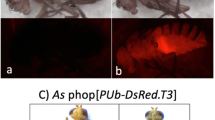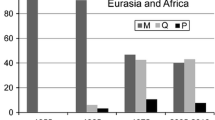Abstract
Mobility of the hobo transposable element was determined for several strains of Drosophila melanogaster and several Drosophila species. Mobility was assessed by use of an in vivo transient assay in the soma of developing embryos, which monitored hobo excision from injected indicator plasmids. Excision was detected in a D. melanogaster strain (cn; ry 42) devoid of endogenous hobo elements only after co-injection of a helper plasmid containing functional hobo transposase under either heat shock or normal promoter regulation. Excision was also detected in D. melanogaster without helper in strains known to contain genomic copies of hobo. In Drosophila species confirmed not to contain hobo, hobo excision occurred at significant rates both in the presence and absence of co-injected helper plasmid. In four of the seven species tested, excision frequencies were two- to fivefold lower in the presence of plasmid-borne hobo. hobo excision donor sites were sequenced in indicator plasmids extracted from D. melanogaster cn; ry 42 and D. virilis embryos. In the presence of hobo transposase, the predominant excision sites were identical in both species, having breakpoints at the hobo termini with an inverted duplication of proximal insertion site DNA. However, in the absence of hobo transposase in D. virilis, excision breakpoints were apparently random and occurred distal to the hobo termini. The data indicate that hobo is capable of functioning in the soma during embryogenesis, and that its mobility is unrestricted in drosophilids. Furthermore, drosophilids not containing hobo are able to mobilize hobo, presumably by a hobo-related cross-mobilizing system. The cross-mobilizing system in D. virilis is not functionally identical to hobo with respect to excision sequence specificity.
Similar content being viewed by others
References
Anxolébèhere D, Periquet G (1987) P-homologous sequences in diptera are not restricted to the Drosophiladae family. Genet Iber 39:211–222
Atkinson PW, Warren WD, O'Brochta DA (1993) The hobo transposable element of Drosophila can be cross-mobilized in houseflies and excises like the Ac element of maize. Proc Natl Acad Sci USA 90:9693–9697
Berg DE, Howe MM (1989) Mobile DNA. American Society for Microbiology, Washington, D.C.
Blackman RK, Gelbart WM (1989) The transposable element hobo of Drosophila melanogaster. In: Berg DE, Howe, MM (eds) Moble DNA. American Society for Microbiology, Washington, D.C., pp 523–525
Blackman RK, Grimaila R; Koehler D, Gelbart WM (1987) Mobilization of hobo elements residing within the decapentaplegic gene complex: suggestion of a new hybrid dysgenesis system in Drosophila melanogaster. Cell 49:497–505
Blackman RK, Macy M, Koehler D, Grimaila R, Gelbart WM (1989) Identification of a fully functional hobo transposable element and its use for germ-line transformation of Drosophila. EMBO J 8:211–217
Calvi BR, Gelbart WM (1994) The basis for germline specificity of the hobo transposable element in Drosophila melanogaster. EMBO J 13:1636–1644
Calvi BR, Hong TJ, Findley SD, Gelbart WM (1991) Evidence for a common evolutionary origin of inverted repeat transposons in Drosophila and plants: hobo, Activator, and Tam3. Cell 66:465–471
Collins J, Saari B, Anderson P (1987) Activation of a transposable element in the germline but not the soma of Caenorhabditis elegans. Nature 328:726–728
Daniels SB, Chovnick A, Boussy IA (1990) Distribution of hobo transposable elements in the genus Drosophila. Mol Biol Evol 7:589–606
Emmons SW, Yesner L (1984) High-frequency excision of transposable element Tc1 in the nematode Caenorhabditis elegans is limited to somatic cells. Cell 36:599–605
Engels WR (1979) Hybrid dysgenesis in Drosophila melanogaster: rules of inheritance of female sterility. Genet Res Camb 33:219–236
Feldmar S, Kunze R (1991) The ORFa protein, the putative transposase of maize transposable element Ac, has a basic DNA binding domain. EMBO J 13:4003–4010
Handler AM, O'Brochta DA (1991) Prospects for gene transformation in insects. Annu Rev Entomol 36:159–183
Handler AM, Gomez SP, O'Brochta DA (1993) A functional analysis of the P-element gene-transfer vector in insects. Arch Insect Biochem Physiol 22:373–384
Haymer DS, Marsh JL (1986) Germ line and somatic instability of a white mutation in Drosophila mauritiana due to a transposable element. Dev Genet 6:281–291
Ho YT, Weber SM, Lim JK (1993) Interacting hobo transposons in an inbred strain and interaction regulation in hybrids of Drosophila melanogaster. Genetics 134:895–908
Kim AI, Belayaeva ES (1991) Transposition of mobile elements gypsy, [MDG4], and hobo in germ-line and somatic cells of genetically unstable mutator strains of Drosophila melanogaster. Mol Gen Genet 229:437–444
Lansman RA, Stacey SN, Grigliatti TA, Brock HW (1985) Sequences homologous to the P mobile element of Drosophila melanogaster are widely distributed in the subgenus Sophophora. Nature 318:561–563
Laski FA, Rio DC, Rubin GM (1986) Tissue specificity of Drosophila P-element transposition is regulated at the level of mRNA splicing. Cell 44:7–19
Lim JK (1981) Site-specific intrachromosomal rearrangements in Drosophila melanogaster: cytogenetic evidence for transposable elements. Cold Spring Harbor Symp Quant Biol 45:553–560
McClintock B (1948) Mutable loci in maize. Carnegie Inst Wash Year Book 47:155–169
McGinnis W, Shermoen AW, Beckendorf SK (1983) A transposable element inserted just 5′ to a Drosophila glue protein gene alters gene expression and chromatin structure. Cell 34:75–84
O'Brochta DA, Handler (1988) Mobility of P elements in drosophilids and nondrosophilids. Proc Natl Acad Sci USA 85:6052–6056
O'Brochta DA, Gomez SP, Handler AM (1991) P element excision in Drosophila melanogaster and related drosophilids. Mol Gen Genet 225:387–394
O'Brochta DA, Warren WD, Saville KJ, Atkinson PW (1994) Transposition of Drosophila hobo elements in non-drosophilid insects. Mol Gen Genet 244:9–14
Pascual L, Periquet G (1991) Distribution of hobo transposable elements in natural populations of Drosophila melanogaster. Mol Biol Evol 8:282–296
Pridmore RD (1987) New and versatile cloning vectors with kanamycin-resistance marker. Gene 56:309–312
Robertson HR (1993) The mariner transposable element is widespread in insects. Nature 362:241–245
Sambrook J, Fritsch EF, Maniatis T (1989) Molecular cloning: a laboratory manual, 2nd edn. Cold Spring Harbor Laboratory Press, Cold Spring Harbor, New York
Sheen F-m, Lim JK, Simmons MJ (1993) Genetic instability in Drosophila melanogaster mediated by hobo transposable elements. Genetics 133:315–334
Simmons GM (1992) Horizontal transfer of hobo transposable elements within the Drosophila melanogaster species complex: evidence from DNA sequencing. Mol Biol Evol 9:1050–1060
Streck RD, MacGaffey JE, Beckendorf SK (1986) The structure of hobo transposable elements and their insertion sites. EMBO J 5:3615–3623
Sulston J, Du Z, Thomas K, Wilson R, Hillier L, Staden R, Halloran N, Green P, Thierry-Mieg J, Qui L, Dear S, Coulson A, Craxton M, Durbin R, Berks M, Metzstein M, Hawkins T, Ainscough R, Waterson R (1992) The C. elegans genome sequencing project: a beginning. Nature 356:37–41
Yannopoulos G, Stamatis N, Monastriati M, Hatzopoulos P, Louis C (1987) hobo is responsible for the induction of hybrid dysgenesis by strains of Drosophila melanogaster bearing the male recombination factor 23.5 MRF. Cell 49:487–495
Author information
Authors and Affiliations
Additional information
Communicated by D. J. Finnegan
Rights and permissions
About this article
Cite this article
Handler, A.M., Gomez, S.P. The hobo transposable element has transposase-dependent and-independent excision activity in drosophilid species. Molec. Gen. Genet. 247, 399–408 (1995). https://doi.org/10.1007/BF00293140
Received:
Accepted:
Issue Date:
DOI: https://doi.org/10.1007/BF00293140




